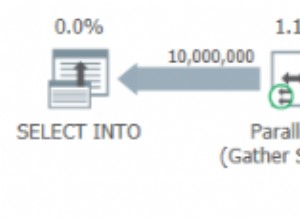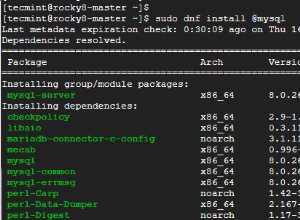Znalazłem odpowiedź online i zaktualizowałem pytanie na tej stronie, aby pokazać innym, jak to się robi.
AKTUALIZACJA — PROBLEM ROZWIĄZANY
Po pierwsze, błędnie sądziłem, że tabela źródłowa (ta w formacie sąsiednich list) musi zostać zmieniona, aby zawierała węzeł źródłowy. Nie o to chodzi. Po drugie, znalazłem klasa za pośrednictwem BING, który załatwia sprawę. Zmieniłem go dla PHP5 i przekonwertowałem bity związane z mysql oryginalnego autora do podstawowego PHP. Używał jakiejś klasy DB. Możesz je później przekonwertować na własną klasę abstrakcji bazy danych, jeśli chcesz.
Oczywiście, jeśli twoja "tabela źródłowa" zawiera inne kolumny, które chcesz przenieść do zagnieżdżonej tabeli zestawu, będziesz musiał dostosować metodę write w klasie poniżej.
Mam nadzieję, że uratuje to kogoś innego przed tymi samymi problemami w przyszłości.
<?php
/**
--
-- Table structure for table `adjacent_table`
--
DROP TABLE IF EXISTS `adjacent_table`;
CREATE TABLE IF NOT EXISTS `adjacent_table` (
`id` int(11) NOT NULL AUTO_INCREMENT,
`father_id` int(11) DEFAULT NULL,
`category` varchar(128) DEFAULT NULL,
PRIMARY KEY (`id`)
) ENGINE=MyISAM DEFAULT CHARSET=latin1 AUTO_INCREMENT=8 ;
--
-- Dumping data for table `adjacent_table`
--
INSERT INTO `adjacent_table` (`id`, `father_id`, `category`) VALUES
(1, 0, 'Books'),
(2, 0, 'CD''s'),
(3, 0, 'Magazines'),
(4, 1, 'Hard Cover'),
(5, 1, 'Large Format'),
(6, 3, 'Vintage');
--
-- Table structure for table `nested_table`
--
DROP TABLE IF EXISTS `nested_table`;
CREATE TABLE IF NOT EXISTS `nested_table` (
`lft` int(11) NOT NULL DEFAULT '0',
`rgt` int(11) DEFAULT NULL,
`id` int(11) DEFAULT NULL,
`category` varchar(128) DEFAULT NULL,
PRIMARY KEY (`lft`),
UNIQUE KEY `id` (`id`),
UNIQUE KEY `rgt` (`rgt`)
) ENGINE=MyISAM DEFAULT CHARSET=latin1;
*/
/**
* @class tree_transformer
* @author Paul Houle, Matthew Toledo
* @created 2008-11-04
* @url http://gen5.info/q/2008/11/04/nested-sets-php-verb-objects-and-noun-objects/
*/
class tree_transformer
{
private $i_count;
private $a_link;
public function __construct($a_link)
{
if(!is_array($a_link)) throw new Exception("First parameter should be an array. Instead, it was type '".gettype($a_link)."'");
$this->i_count = 1;
$this->a_link= $a_link;
}
public function traverse($i_id)
{
$i_lft = $this->i_count;
$this->i_count++;
$a_kid = $this->get_children($i_id);
if ($a_kid)
{
foreach($a_kid as $a_child)
{
$this->traverse($a_child);
}
}
$i_rgt=$this->i_count;
$this->i_count++;
$this->write($i_lft,$i_rgt,$i_id);
}
private function get_children($i_id)
{
return $this->a_link[$i_id];
}
private function write($i_lft,$i_rgt,$i_id)
{
// fetch the source column
$s_query = "SELECT * FROM `adjacent_table` WHERE `id` = '".$i_id."'";
if (!$i_result = mysql_query($s_query))
{
echo "<pre>$s_query</pre>\n";
throw new Exception(mysql_error());
}
$a_source = array();
if (mysql_num_rows($i_result))
{
$a_source = mysql_fetch_assoc($i_result);
}
// root node? label it unless already labeled in source table
if (1 == $i_lft && empty($a_source['category']))
{
$a_source['category'] = 'ROOT';
}
// insert into the new nested tree table
// use mysql_real_escape_string because one value "CD's" has a single '
$s_query = "
INSERT INTO `nested_table`
(`id`,`lft`,`rgt`,`category`)
VALUES (
'".$i_id."',
'".$i_lft."',
'".$i_rgt."',
'".mysql_real_escape_string($a_source['category'])."'
)
";
if (!$i_result = mysql_query($s_query))
{
echo "<pre>$s_query</pre>\n";
throw new Exception(mysql_error());
}
else
{
// success: provide feedback
echo "<p>$s_query</p>\n";
}
}
}
mysql_connect('localhost','USER','PASSWORD') or die(mysql_error());
mysql_select_db('DATABASE') or die(mysql_error());
// build a complete copy of the adjacency table in ram
$s_query = "SELECT `id`,`father_id` FROM `adjacent_table`";
$i_result = mysql_query($s_query);
$a_rows = array();
while ($a_rows[] = mysql_fetch_assoc($i_result));
$a_link = array();
foreach($a_rows as $a_row)
{
$i_father_id = $a_row['father_id'];
$i_child_id = $a_row['id'];
if (!array_key_exists($i_father_id,$a_link))
{
$a_link[$i_father_id]=array();
}
$a_link[$i_father_id][]=$i_child_id;
}
$o_tree_transformer = new tree_transformer($a_link);
$o_tree_transformer->traverse(0);
?>
Oto wynik:




